Abstract
This paper discusses the general conditions relating to ballistic head protection, analyzing the risks that may occur on contemporary battlefields. A thorough literature review has enabled us to present development trends for helmets used in the largest armies in the world. The authors have focused on impacts to the helmet shell, overloading the entire helmet-protected head–neck system. The main objective of this study is to investigate the protective capability of a helmet shell when subjected to projectile–helmet contact, with contact curvature taken as being an indicator of the impact energy concentration. Blunt head trauma was estimated using backface deformation (BFD). The Wz.93 combat helmet was used for testing. Analytically, dependencies were derived to determine the scope of BFD. A five-parameter model of the helmet piercing process was adopted, thus obtaining the optimal BFD range. Verification of theoretical considerations was carried out on a specially developed research stand. In the ballistic tests, dynamic deflection of the helmet’s body was registered using a speed camera. On the impact testing stand, a fragment of the helmet was pierced, producing results in the low impact velocity range. Data have been presented on the appropriate graph in order to compare them with values specified in the relevant standard and existing literature. Our results correlate well with the norm and literature values.
1. Introduction
The modern approach to promoting the survival of soldiers on the battlefield involves a series of processes related to the design of appropriate personal protective ballistic shields. This must be assessed comprehensively for all scenarios where, on the one hand, a soldier’s body is affected by impact energy and, on the other hand, the energy is absorbed in such a way that it gets distracted by a suitable absorber (a helmet or bulletproof vest, etc.), designed to protect human body surface from exposure to serious blunt injuries caused by the inertia forces of ballistic shields influencing a human body. In this case, firstly, the procedure shown in Figure 1 must be followed when setting out to design an effective ballistic shield.
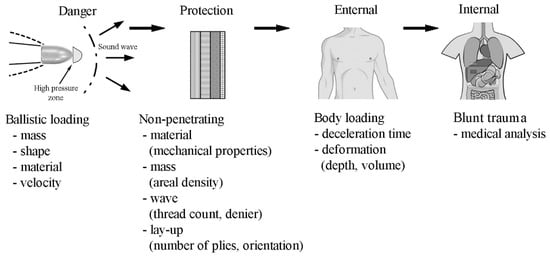
Figure 1.
Factors affecting the efficient construction of personal ballistic protective covers.
To understand the problem, reference should be made to the risks generated on modern battlefields and the development trends of ballistic shields, in conjunction with a detailed analysis of injuries in physical, biomechanical, and medical terms. Furthermore, this work will focus attention on analysis of head protection in terms of blunt trauma caused by shots to domestically produced helmets from small firearms. The authors undertook an assessment of the protective capabilities of the Wz.93 composite combat helmet, designed for land forces. An assessment of the effectiveness of this head protection was based on a backface deformation (BFD) identification index. So far, military helmets have only been tested in terms of resistance to perforation. In the approach proposed here, assessment of the effectiveness of the protective helmet also takes into account the phenomenon of blunt head injury.
2. Analysis of Risks and Their Minimization
Analysis of the literature [,,,,] shows that 90% of gunshot wounds are those caused by fragments, and only 10% of wounds are inflicted after a direct hit from various types of ammunition projectiles. Most wounds affect limbs (approximately 61% to the head and neck, approximately 12% to the abdomen and chest, and approximately 27% to limbs and other parts of the body (see Table 1)). It can be argued that limb wounds are most traumatic for soldiers on the battlefield and further work should be aimed at reducing these injuries. However, head and neck injuries have the most dramatic consequences. As shown in Table 1, the percentage of head injuries has increased in recent armed conflicts. This is a consequence of changes in the tactics of contemporary armed conflict, where firing may come from a previously unrecognized direction, in which case the current assessment of helmet protective capability should be supplemented with new types of risks. Figure 2 shows the typical zones where penetrating injuries are concentrated [].

Table 1.
Relative distribution of general injuries to different parts of the human body surface (%) [,,,].
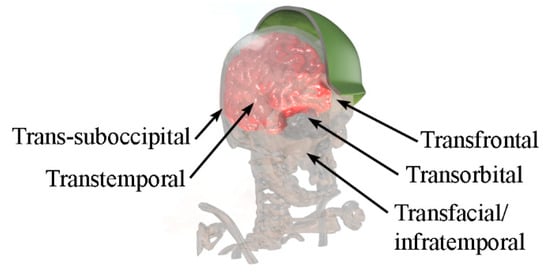
Figure 2.
Areas most commonly associated with head injuries resulting from typical hazards generated on the battlefield.
As has been shown in recent armed conflicts [], the main threats causing head injuries can be divided into three groups: ballistic, blunt, and explosive (see Table 2).

Table 2.
Categories of risk adopted from []. IED: improvised explosive device.
These result from war operations, namely, detonation of unclassified explosives, ballistics, and fragmentation impacts and injuries suffered during typical maintenance activities and operation of weaponry, as well as random accidents in everyday soldier life, including car accidents, etc. Their characteristic operation time is depicted in Figure 3.
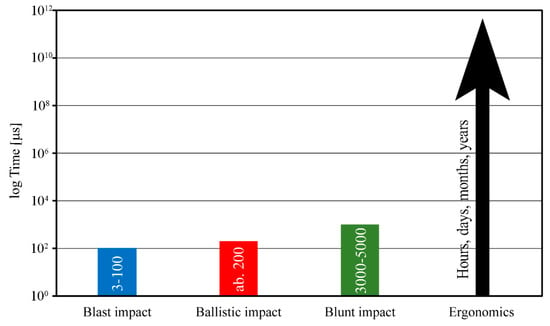
Figure 3.
Comparison of the duration of injuries generated by explosive, ballistic, and blunt impacts associated with injuries related to ergonomics.
These categories vary depending on the duration of the impulse of force during which an injury is sustained, and the distance from the epicenter of an event. As pointed out [,,,,,], traumas arising from blast impact are experienced within 3 to 100 microseconds of an event and, with a ballistic impact, within about 200 microseconds. In this case, high temperature is also an additional element of trauma. Blunt impact is a consequence of the two abovementioned categories, and the time in which it appears is determined by many factors, such as the velocity of wave propagation in a medium (place), etc. If injuries are associated with the use of arms or soldier operations in conditions involving difficult terrain (defined as ergonomic), the time they take to affect the human body is currently counted in units per day or per year. However, it should be emphasized that blunt trauma resulting from blast or ballistic impacts can also be revealed after a certain time since processes occurring in the brain are very difficult to diagnose (see Figure 2).
As the head is the most important human organ, it needs particular protection. For this purpose, helmets [,] are used with the aim of reducing the effects of so-called traumatic brain injury (TBI) as a result of projectile impact (see Figure 4).

Figure 4.
The mechanism causing blunt force brain injuries.
Helmets have been commonly worn to protect the head since antiquity, and have evolved in line with the development of technology and materials engineering. Earlier solutions were based on a shell (a body) made of suitable steel. In the first half of the twentieth century, after the first fiber composites had been developed, helmet shells started to be constructed using modern materials solutions [,,,,,,]. Modern structures largely reflect existing knowledge, not only in the sense of physical analyses but also in the search for mathematical models through which biomechanical issues can be explored []. There has also been a great leap forward in medicine in terms of the development of neurosurgery, which can explain many of the injuries presented in Table 2. This concentration is highlighted in the development trends of modern head coverings (see Figure 5) [,,].
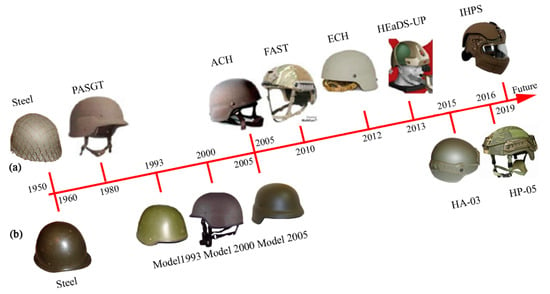
Figure 5.
Evolution of helmets from World War II to the present day: (a) US Army; (b) Polish Army.
3. Formulation of the Problem
Based on the literature review [,,,,], it can be stated that the selected parameters for the requirements of bodily injury criteria (including the head) have been developed for car accidents [,,]. Adopting these for ballistic impacts requires some correlations. Although there are similar physical characteristics in both cases (a car accident and a ballistic impact), predictions regarding injuries are different. The application of parameters, such as head injury criteria (HIC) or acceleration [,,,,], when assessing a head injury is not the ultimate criterion. The relationship between energy level and injury severity when determining the blunt criterion (BC) [,,,] should also be taken into account when considering a ballistic impact. The main problem with defining the BC parameter is determining the local curvature of a striking projectile and a head (which greatly complicates the estimation of this criterion []) and the probability of determining the extent of trauma suffered in accordance with the Abbreviated Injury Scale (AIS). This scale ranges from 1 to 6 (see Table 3), where 1 is a minor injury seldom requiring medical treatment, and 6 stands for a 100 percent probability of death. Any injury greater than AIS level 3 is considered life-threatening.

Table 3.
Levels of the Abbreviated Injury Scale adopted from [].
When a helmet protecting a head is impacted by a projectile, kinetic energy is transferred within a small area and the helmet simultaneously undergoes deformation. Propagation of the deformation (in the form of deflection) in the rear part of a helmet is defined as a BFD, and may be brought into contact with a part of the skull, causing extensive load [,]. Shock waves affecting the helmet surface transfer the load further inwards and indirectly influence the skull. The significance of this influence is the result of the deformation value of the helmet’s shell []. As the BFD parameter increases, the risk of serious head injuries in the form of TBIs [,] and skull fractures also increases. This type of helmet is designed to reduce traumatic brain injuries (TBIs), and the criterion for assessing the protective properties of this TBI-based helmet relates to medical aspects of the brain injury. Some studies [,] have undertaken in-depth analysis of the correlation between head kinematics and the response of brain tissue. This effect often manifests itself after a long delay (see Figure 3) and requires a neurosurgical assessment. In this article, the TBI parameter has been accentuated due to its importance in a comprehensive assessment of head injury. Authors [,,] have indicated that such injuries require analysis using a medical approach, but this article is limited to the identification in mechanical and biomechanical terms, leaving aside the medical aspect.
The first studies [,] focused on determining the value of the force required to cause a skull fracture with deflection off the frontal bone. The author of the work [] carried out a preliminary study involving shooting at the helmet surface with 9 mm ammunition in order to estimate the BC for a head. Initial results confirmed assumptions made about the possibility of experiencing a blunt head injury from BFD impact. However, this problem requires accurate analyses because much uncertainty remains.
Estimating the BC for a head constitutes a complex problem. Determining the scope of a helmet’s BFD (the value specified in the National Institute of Justice (NIJ) Standard for Ballistic Helmets) as the contact geometry (the curvature of contact between a helmet and a projectile) poses considerable problems associated with determining the actual diameter of the surface [] (see Figure 6).
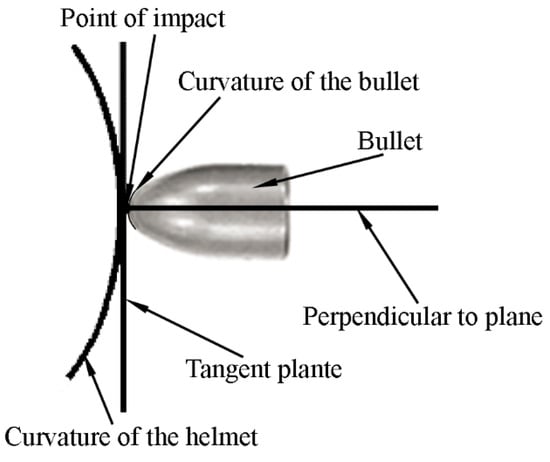
Figure 6.
Schematic showing contact between a projectile and a helmet.
Changing local collision during impact of a projectile on a helmet complicates the issue [,]. The scope of deflection results from the energy of the ballistic impact on a helmet. Starting from the general mathematical model of the BC [] expressed in the form of
where
- m—mass of the projectile;
- v—velocity of the projectile;
- M—mass of the helmet and head;
- t—thickness of the body wall;
- d—diameter of the projectile;
the limits of the surface range can be estimated as a function of the dynamic deflection.
Put more simply, on the basis of interdependences appearing according to the accepted mechanism for estimating a head injury (see Figure 7).
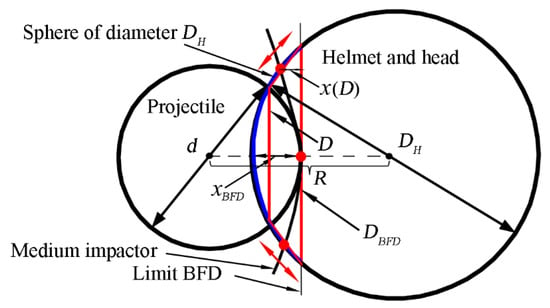
Figure 7.
Mechanism for estimating backface deformation (BFD).
Deformation energy (Edef) is computed as
where
- D—effective diameter;
- DH—body diameter;
- DBFD—flat limit of diameter;
- xBFD—range of depth;
- d—diameter of the projectile;
- tH—thickness of the helmet wall.
After the conversion of Equation (2), the deformation energy can be saved as
where MEM is effective mass according to [].
Given the contact diameter (D) for a given impactor mass and velocity (kinetic energy), the minimum allowable impactor diameter (d) can be calculated by
where 2t < D ≤ DBFD. Given the impactor diameter, we calculate the depth of the depression (xBFD) to be:
where R is the distance between the sphere centers (see Figure 7).
On the basis of Relation (4), when d tends to infinity, parameter D is approaching the range DBFD. With increasing impact velocity, increased deformation energy must be distributed over a larger contact surface in order to keep the ratio of injuries at the desired level. The adopted value of the BFD index constitutes a restriction, and its excess (over 50%) is associated with the probability of a serious head injury (skull fracture). In the literature [], it is assumed that 76 joules of energy (as the maximum allowable deflection during impact with a density of about 1.6 J/cm2) is the threshold value.
4. Subject and Scope of the Study
The subject of this study is the composite combat helmet, model Wz.93, in domestic production (see Figure 8), which was subjected to shooting with 9 mm full metal jacket (FMJ)-type Parabellum cartridges with a weight of 8 g. The purpose of this study is to define the value of the BFD parameter, thereby answering the question as to whether (and to what extent) dynamic deflection specified as BFD can cause injury to a protected head.

Figure 8.
View of the composite combat helmet, model Wz.93: (a) helmet shell; (b) geometric model; (c) helmet lining.
Ballistic tests were performed on a ballistic track with a specially designed helmet mounting system while maintaining appropriate rigidity (see Figure 9). Applied restrictions involved firing at a helmet installed with appropriate equipment but without a headform. In a subsequent stage, the impact machine was used to simulate impact of a projectile on the helmet shell coating. The impact machine used in the study was the Instron Dynatup 9250HV (see Figure 10). The characteristic features of the machine are as follows:
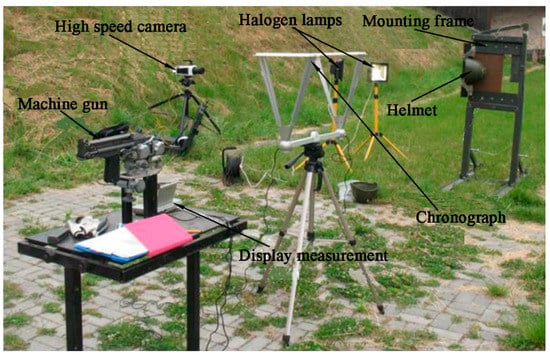
Figure 9.
Layout of the test devices.
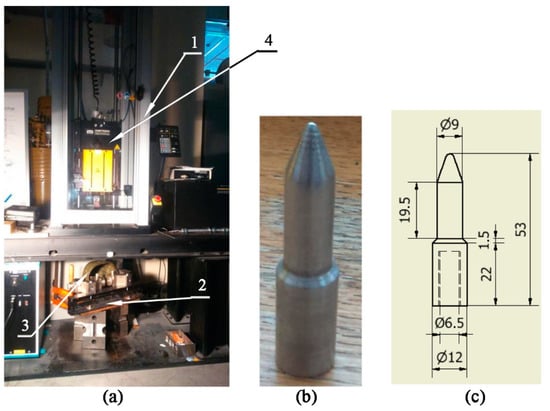
Figure 10.
Impact testing stand: (a) impact machine; (b) impactor; (c) dimensioned impactor: (1) impact machine; (2) helmet mounting hooks; (3) mounted helmet; (4) the head being struck.
- -
- maximum velocity with the forced drive: 20 m/s;
- -
- maximum simulated drop height: 20.4 m;
- -
- impact energy range: from 4.5 to 1600 J;
- -
- impact standard head: energy range from 4.5 to 940 J;
- -
- impact heavy head: energy range from 25 to 1600 J;
- -
- environmental test chamber: temperature range from −51 °C to 177 °C.
The helmet was scanned before tests and after each shot (see Figure 8b) in order to obtain a three-dimensional image of deformations using an Absolute Arm scanner.
5. Results and Discussion
After firing, the results were obtained in the form of shadow photography images taken by the high-speed camera, as shown in Figure 11.
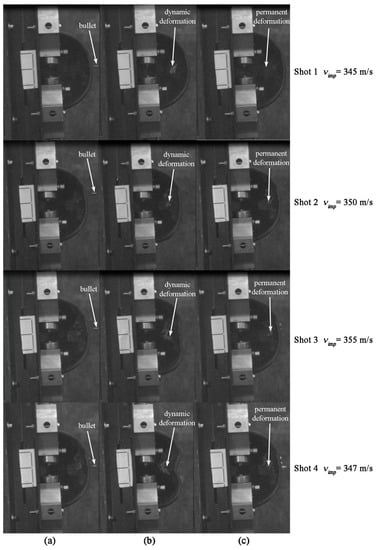
Figure 11.
Shadow photographs taken by the high-speed camera: (a) recorded projectile before striking the helmet shell; (b) moment of dynamic deflection; (c) after striking, with the registered permanent deflection.
Based on a visual inspection, it was observed that all the hits were stopped, and the deformed projectiles were stuck in the shell. The expected value of xBFD was obtained at 20 mm for shot number 1 and at 22 mm for number 2. The estimated dynamic deflection recorded by the fast camera was within BFD tolerance since it did not exceed 25.4 mm. The measured BDF parameter values are summarized in Table 4. Perforations of the laminate in the inner part of the helmet were observed for the third and fourth shots (see Figure 12). This method was used to assess the protective capability of the helmet’s shell in a series of gunshots. The size of the firing area was kept constant, and shots were arranged in a circle with a diameter of 100 mm. Shot number 3 produced 28 mm dynamic deflection values, and shot number 4 produced 34 mm dynamic deflection values. The BFD range for the third and fourth shots did not fall within the accepted range for safe dynamic deflection. The helmet did not retain its parameters (xBFD) when subjected to a series of shots.

Table 4.
Summary of test results obtained.
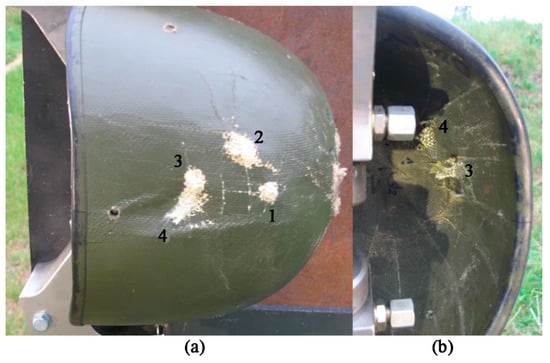
Figure 12.
View of the helmet after firing: (a) front side of the shell; (b) interior of the shell.
The parameters of damage (taken by the scanner using a reverse engineering technique) were applied to compare damage from the ballistic tests. After the fourth shot, global deformation of the helmet’s durable shell (recorded with a 3D scanner) was found to measure approximately 14 mm (see Figure 13). The lowest estimated global deformation value registered by the camera was about 10 mm. The difference is 28%, and relates to an error in interpreting the recorded shadow photography.
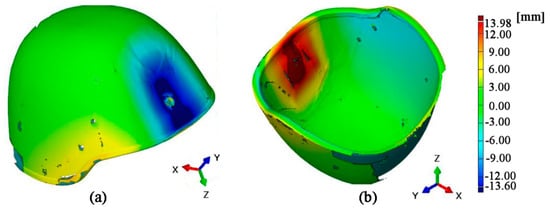
Figure 13.
Image deformation of the helmet using the 3D scanner: (a) outside of the shell; (b) inside of the shell (deformation along the x-axis).
The impact machine recorded the maximum force and energy values of piercing by the cartridges, as well as duration of impact, and dynamic and stable deflection of the helmet. The tests were carried out under piercing conditions identical to those of gunfire, and the diameter of the circle remained at 100 mm. In this case, dynamic deflection results for the helmet shell were twice as large as those from the ballistic tests. This is mainly related to the speed of deformation of the shell helmet during dynamic tests and impulse loads. An example of registered parameters, including maximum force and maximum piercing energy, is shown in Figure 14.
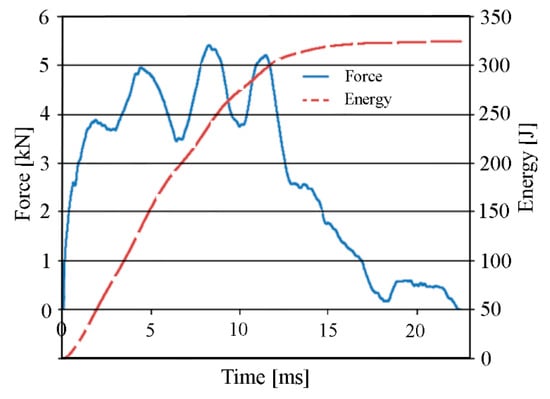
Figure 14.
Diagram of force and energy as a function of time for the fourth shot.
The obtained parameters (estimated during the ballistic tests and testing on the impact machine), are shown in Table 4. In order to make it possible to estimate the BFD parameter in the function of the contact surface of an impact and a head, the deformation of a projectile must be examined carefully. As shown in Figure 15, the contact surface increases along with penetration into the helmet shell. A desirable solution would be to mushroom the bullet as much as possible in the first phase of deflection of the dynamic helmet shell.

Figure 15.
Summary of deformed projectiles as a result of firing at a helmet shell and an undeformed projectile: (a) and (d): fronts of the mushroom projectile; (b) and (e): rear part of the deformed projectiles; (c) undeformed projectile.
The summarized correlations of the scope of penetration as a function of velocity for the 9 mm Parabellum projectile with the Wz.93 combat helmet (see Figure 16) compare favorably for speeds of 350 m/s. At higher pistol projectile speeds, this helmet no longer meets modern criteria, as shown in the graph (see Figure 16). Even though the helmet had exceeded its service life, it still had some good protective properties but only at level II of the standard []. The current standard is level III for 420 ± 15 m/s. Its penetration in the function of time is presented in Figure 17, in order to enable estimation of the duration of the event. In this case, the following results were achieved: the shortest time was recorded for a force value of 4.13 kN where the event time was 9.5 ms. The longest time of 22.4 ms was recorded for a force value of 5.41 kN. The xBFD range grew linearly over time.
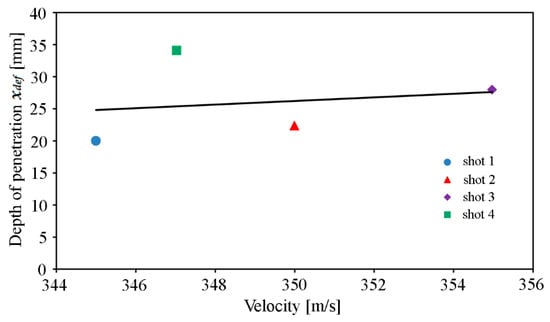
Figure 16.
Estimation of BFD as a function of velocity for 9 × 19 mm full metal jacket (FMJ)-type Parabellum.
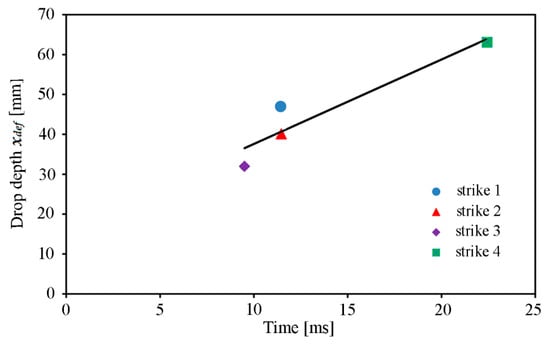
Figure 17.
Estimation of dynamic deflection (BFD) as a function of time from the impact machine.
The helmet, subjected to piercing using the impact machine, retains all of the capabilities of ballistic protection. The presented graphs show that the BFD parameter depends on the speed of impact. In view of the above, ways should be sought to increase the levels of helmet protection by increasing the field of impact energy dissipation. In an era of materials engineering development, detailed analysis of the process of destruction is required (in physical terms) to promote protectiveness without increasing the weight of the helmet. Helmet weight reduction is dictated by overload protection of the head–neck system.
6. Conclusions
Based on the analysis of development trends for combat helmets currently used in the largest army in the world (the United States) and the Polish armed forces, it has been concluded that the helmets used for protection purposes in our army are capable of withstanding only the first two threats (see Table 2). In the case of blast explosives, there is a very high risk of the wearer suffering a traumatic brain injury from the acoustic effect of propagation of the free explosion wave. The helmets used in our army correspond to the American Advanced Combat Helmet (ACH) and Future Assault Shell Technology (FAST) programs (2005–2010), which means that they are from three generations ago with helmet electronics and display system (heads-up), and future (ballistic/blast/blunt trauma) or the latest standard intelligent hypersensor processing system (IHPS).
Nonetheless, based on the obtained results, it can be stated that the analyzed structure is only capable of dealing with a single strike. If hits like those of the multi-hit model were recorded, the standards (xdef) would be exceeded. The obtained dynamic deflection and permanent deflection results did not exceed the limit values (see Table 4). As shown in Figure 11b, the estimated dynamic deflection for shot number three or four could cause serious skull trauma, although other results from the firing were within the tolerance limits of current standards (see Figure 18) []. In comparison with data received from the impact machine, dynamic deflection was found to be outside the desired range. The duration of the event was within the required range and (based on []) did not exceed 15 m/s. Estimating the depth of the deflection (xBFD) when determining the BC, where the limit of permanent deflection was estimated to be approximately 7–15 mm [], the registered deflections (see Figure 18) were on the borderline of skull injury (fracture). Referring to Table 3, the likelihood of injury occurrence is, therefore, AIS 3+ for BC.
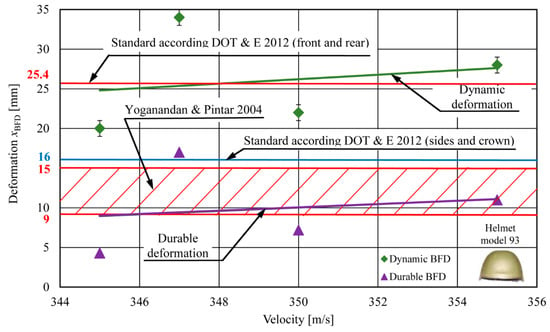
Figure 18.
Estimation of deflection xBFD as a function of speed from the ballistic test in the light of standards and literature.
The results presented in this paper were performed on the helmet only, and are burdened with error, future studies should endeavor to estimate headform injuries using standardized equipment. A detailed analysis of changes in the impactor surface (mushroom projectile) is planned as it would be a mistake not to consider increasing the diameter of the surface involved in the process of absorbing impact energy when estimating actual indicators of the BC.
Author Contributions
Conceptualization, K.J., M.B. (Miroslaw Bocian), and S.P.; Methodology, M.B. (Marcin Bajkowski), M.K., R.S., and M.M.; Validation, K.J., and M.K.; Formal Analysis, K.J., M.B. (Miroslaw Bocian), and S.P.; Investigation, K.J., R.S., and M.K.; Resources, M.B. (Marcin Bajkowski), and M.M.; Data Curation, K.J., M.K.; Writing—Original Draft Preparation, K.J., M.K., and M.B. (Marcin Bajkowski); Writing—Review & Editing, M.M., and S.P.; Visualization, M.B. (Miroslaw Bocian), and S.P.; Supervision, K.J., and M.B. (Marcin Bajkowski)
Funding
This research received no external funding.
Conflicts of Interest
The authors declare no conflict of interest.
Acronyms and Abbreviations
| ACH | Advanced Combat Helmet |
| AIS | Abbreviated Injury Scale |
| BC | blunt criterion |
| BFD | backface deformation |
| ECH | Enhanced Combat Helmet |
| FAST | Future Assault Shell Technology |
| FMJ | full metal jacket |
| HEaDS-UP | Helmet Electronics and Display System-Upgradeable Protection |
| HIC | head injury criterion |
| IED | improvised explosive device |
| IHPS | integrated head protection system |
| NIJ | National Institute of Justice |
| PASGT | Personnel Armor System for Ground Troops |
| TBI | traumatic brain injury |
References
- Cooper, G.; Gotts, P. Ballistic Protection. In Ballistic Trauma. A Practical Guide, 2nd ed.; Mahoney, P.F., Ryan, J.M., Brooks, A.J., Schwab, C.W., Eds.; Springer: London, UK, 2005; pp. 67–90. [Google Scholar]
- Owens, B.D.; Kragh, J.F.; Wenke, J.C.; Macaitis, J.; Wade, C.E.; Holcomb, J.B. Combat wounds in Operation Iraqi Freedom and Operation Enduring Freedom. J. Trauma 2008, 64, 295–299. [Google Scholar] [CrossRef]
- Jones, R.D.; Ness, L.S. Jane’s Infantry Weapons 2011–2012, 37th ed.; His: Coulsdon, UK, 2012. [Google Scholar]
- Wojcik, B.E.; Stein, C.R.; Bagg, K.; Humphrey, R.J.; Orosco, J. Traumatic brain injury hospitalizations of U.S. Army soldiers deployed to Afghanistan and Iraq. Am. J. Prev. Med. 2010, 38, 108–116. [Google Scholar] [CrossRef] [PubMed]
- Jamroziak, K. Evaluation of gunshot wounds in aspect of injury criterion. Aktualne Probl. Biomech. 2016, 11, 33–46. [Google Scholar]
- Cubano, M.A.; Lenhart, M.K. Emergency War Surgery, 4th United States Revision ed.; The Office of the Surgeon General Borden Institute: Fort Sam Houston, TX, USA, 2013; pp. 213–234. [Google Scholar]
- Bellamy, R.F. The medical effects of conventional weapons. World J. Surg. 1992, 16, 888–892. [Google Scholar] [CrossRef] [PubMed]
- Carey, M.E.; Joseph, A.S.; Morris, W.J.; Mcdonnell, D.E.; Rengachary, S.S.; Smythies, C.; William, S.J.P., 2nd; Zimba, F.A. Brain wounds and their treatment in VII Corps during Operation Desert Storm, February 20 to April. Mil. Med. 1998, 163, 581–586. [Google Scholar] [CrossRef] [PubMed]
- Tan, L.B.; Tse, K.M.; Tan, Y.H.; Sapingi, M.A.B.; Tan, V.B.C.; Lee, H.P. Face Shield Design against Blast-induced Head Injuries. Int. J. Numer. Method Biomed. Eng. 2017, 33, e2884. [Google Scholar] [CrossRef]
- Committee on Review of Test Protocols Used by the Department of Defense to Test Combat Helmets. Review of Department of Defense Test Protocols for Combat Helmets; National Academies Press (US): Washington, DC, USA, 2014. [Google Scholar] [CrossRef]
- Sone, J.Y.; Kondziolka, D.; Huang, J.H.; Samadani, U. Helmet efficacy against concussion and traumatic brain injury: A review. J. Neurosurg. 2017, 126, 768–781. [Google Scholar] [CrossRef] [PubMed]
- Bhatnagar, A. Lightweight Ballistic Composites. Military and Law-Enforcement Applications, 2nd ed.; Elsevier: Cambridge, UK, 2016. [Google Scholar]
- Walsh, S.M.; Vargas-Gonzalez, L.R.; Scott, B.R.; Lee, D. Developing an Integrated Rationale for Future Head Protection in Materials and Design; U.S. Army Research Laboratory, Aberdeen Proving Ground: Aberdeen, UK, 2012. [Google Scholar]
- Jamroziak, K. The evaluation of head injuries in soft ballistic protection. Modelowanie Inżynierskie 2011, 42, 179–190. [Google Scholar]
- Jamroziak, K.; Pyka, D.; Pach, J.; Bocian, M.; Kurzawa, A.; Kurowski, J. Dissipative Properties of Non-Newtonian Fluid Under Impact Load. In Engineering Mechanics, Proceedings of the 24th International Conference; Fischer, C., Naprstek, J., Eds.; Institute of Theoretical and Applied Mechanics of the Czech Academy of Sciences: Prague, Czech Republic, 2018; pp. 321–324. [Google Scholar]
- Ptak, M.; Kaczynski, P.; Fernandes, F.A.O.; Alvesde Sousa, R.J. Assessing impact velocity and temperature effects on crashworthiness properties of cork material. Int. J. Impact Eng. 2017, 106, 238–248. [Google Scholar] [CrossRef]
- Antolak-Dudka, A.; Platek, P.; Durejko, T.; Baranowski, P.; Malachowski, J.; Sarzynski, M.; Czujko, T. Static and Dynamic Loading Behavior of Ti6Al4V Honeycomb Structures Manufactured by Laser Engineered Net Shaping (LENSTM) Technology. Materials 2019, 12, 1225. [Google Scholar] [CrossRef]
- Kucewicz, M.; Baranowski, P.; Malachowski, J.; Poplawski, A.; Platek, P. Modelling, and characterization of 3D printed cellular structures. Mater. Des. 2018, 142, 177–189. [Google Scholar] [CrossRef]
- Balandina, D.V.; Bolotnikb, N.N.; Pilkeyc, W.D. Capabilities of helmets for preventing head injuries induced by ballistic impacts. Shock Vib. 2004, 11, 547–562. [Google Scholar] [CrossRef][Green Version]
- Kulkarni, S.G.; Gao, X.-L.; Horner, S.E.; Zheng, J.Q.; David, N.V. Ballistic helmets—Their design, materials, and performance against traumatic brain injury. Compos. Struct. 2013, 101, 313–331. [Google Scholar] [CrossRef]
- Inspector General Department of Defense. Advanced Combat Helmet Technical Assessment; Report No. DODIG-2013-079; Inspector General Department of Defense: Alexandria, WV, USA, 2013.
- The Offer of National Production Helmets. Available online: https://www.maskpol.com.pl/produkty.html (accessed on 12 February 2019).
- Bir, C.; Eck, J. Preliminary Analysis of Blunt Ballistic Impacts to the Abdomen. In IUTAM Symposium on Impact Biomechanics: From Fundamental Insights to Applications. Solid Mechanics and Its Applications; Gilchrist, M.D., Ed.; Springer: Dordrecht, The Netherlands, 2005; Volume 124, pp. 25–32. [Google Scholar]
- Baranowski, P.; Damaziak, K.; Malachowski, J.; Mazurkiewicz, L.; Muszynski, A. A child seat numerical model validation in the static and dynamic work conditions. Arch. Civ. Mech. Eng. 2015, 15, 361–375. [Google Scholar] [CrossRef]
- NATO Unclassified Releasable to PFP and ZAF. Test Methodology for Protection of Vehicle Occupants Against Anti-Vehicular Landmine and/or IED Effects; RTO Technical Report TR-HFM-148; Neuilly-sur-Seine Cedex, France, 2012. [Google Scholar]
- Mazurkiewicz, L.; Baranowski, P.; Karimi, H.R.; Damaziak, K.; Malachowski, J.; Muszynski, A.; Muszynski, A.; Robbersmyr, K.G.; Vangi, D. Improved child-resistant system for better side impact protection. Int. J. Adv. Manuf. Technol. 2018, 97, 3925–3935. [Google Scholar] [CrossRef]
- Fernandes, F.A.O.; Alves de Sousa, R.J.; Ptak, M. Head Injury Simulation in Road Traffic Accidents; Springer: Cham, Switzerland, 2018. [Google Scholar]
- Joszko, K.; Wolanski, W.; Burkacki, M.; Suchon, S.; Zielonka, K.; Muszynski, A.; Gzik, M. Biomechanical analysis of injuries of rally driver with head supporting device. Acta Bioeng. Biomech. 2016, 18, 160–169. [Google Scholar]
- Ptak, M. Method to Assess and Enhance Vulnerable Road User Safety during Impact Loading. Appl. Sci. 2019, 9, 1000. [Google Scholar] [CrossRef]
- Lankarani, H. Development of a Component Head Injury Criteria (HIC) Tester for Aircraft Seat Certification; Report No. DOT/FAA/AR-02-99; Department of Transportation/Federal Aviation Administration: Washington, DC, USA, 2002.
- Duma, S.M.; Manoogian, S.J.; Bussone, W.R.; Brolinson, P.G.; Goforth, M.W.; Donnenwerth, J.J.; Greenwald, R.M.; Chu, J.J.; Crisco, J.J. Analysis of real-time head accelerations in collegiate football players. Clin. J. Sport Med. 2005, 15, 3–8. [Google Scholar] [CrossRef] [PubMed]
- Henn, H.W. Crash Test and the Head Injury Criterion. Teach. Math. Its Appl. 1998, 17, 162–170. [Google Scholar] [CrossRef]
- Ptak, M.; Kaczynski, P.; Ratajczak, M.; Kwiatkowski, A.; Sawicki, M.; Wilhelmm, J.; Fernandes, F.A.O.; Druszcz, A. Investigation of biomechanics of skull structures damages caused by dynamic loads. Acta Bioeng. Biomech. 2018, 20, 143–150. [Google Scholar] [PubMed]
- Viano, D.C.; Andrzejak, D.V.B.S.; Polley, T.M.D.; King, A.I. Mechanism of fatal chest injury by baseball impact: Development of an experimental model. Clin. J. Sport Med. 1992, 2, 166–171. [Google Scholar] [CrossRef]
- Clare, V.R.; Sturdivan, L.M.; Mickiewicz, A.P.; Lewis, J.H. Blunt Trauma Data Correlation; Belvoir Defense Technical Information Center, U.S. Department of Commerce: Washington, DC, USA, 1975.
- Sturdivan, L.M.; Viano, D.C.; Champion, H.R. Analysis of injury criteria to assess chest and abdominal injury risks in blunt and ballistic impacts. J. Trauma 2004, 56, 651–663. [Google Scholar] [CrossRef] [PubMed]
- Bayly, P.V.; Cohen, T.S.; Leister, E.P.; Ajo, D.; Leuthard, E.C.; Genin, G.M. Deformation of the human brain induced by mild acceleration. J. Neurotrauma 2005, 22, 845–856. [Google Scholar] [CrossRef] [PubMed]
- Civil Aviation Safety Authority. Human Injury Model for Small Unmanned Aircraft Impacts; Monash University: Melbourne, Australia, 2013. [Google Scholar]
- Rafaels, K.A.; Cutcliffe, H.C.; Salzar, R.S.; Davis, M.; Boggess, B.; Bush, B.; Harris, R.; Rountree, M.S.; Sanderson, E.; Campman, S.; et al. Injuries of the head from backface deformation of ballistic protective helmets under ballistic impact. J. Forensic Sci. 2015, 60, 219–225. [Google Scholar] [CrossRef]
- Weisenbach, C.A.; Logsdon, K.; Salzar, R.S.; Chancey, V.C.; Brozoski, F. Preliminary Investigation of Skull Fracture Patterns Using an Impactor Representative of Helmet Back-Face Deformation. Mil. Med. 2018, 183, 287–293. [Google Scholar] [CrossRef] [PubMed]
- Cai, Z.; Li, Z.; Dong, J.; Mao, Z.; Wang, L.; Xian, C.J. A study on protective performance of bullet-proof helmet under impact loading. J. Vibroeng. 2016, 18, 2495–2507. [Google Scholar]
- Raymond, D.; Van, E.C.; Crawford, G.; Bir, C. Tolerance of the skull to blunt ballistic temporo-parietal impact. J. Biomech. 2009, 42, 2479–2485. [Google Scholar] [CrossRef] [PubMed]
- Sarvghad-Moghaddam, H.; Rezaei, A.; Ziejewski, M.; Karami, G. CFD modeling of the underwash effect of military helmets as a possible mechanism for blast-induced traumatic brain injury. Comput. Methods Biomech. Biomed. Eng. 2017, 20, 16–26. [Google Scholar] [CrossRef] [PubMed]
- Sarvghad-Moghaddam, H.; Rezaei, A.; Ziejewski, M.; Karami, G. Correlative analysis of head kinematics and brain’s tissue response: A computational approach toward understanding the mechanisms of blast TBI. Shock Waves 2017, 27, 919–927. [Google Scholar] [CrossRef]
- Sarvghad-Moghaddam, H.; Salimi, M.; Rezaei, A.; Karami, G.; Ziejewski, M. Examination of the protective roles of helmet/faceshield and directionality for human head under blast waves. Comput. Methods Biomech. Biomed. Eng. 2015, 18, 1846–1855. [Google Scholar] [CrossRef] [PubMed]
- Wang, F.; Han, Y.; Wang, B.; Peng, Q.; Huang, X.; Miller, K.; Wittek, A. Prediction of brain deformations and risk of traumatic brain injury due to closed-head impact: Quantitative analysis of the effects of boundary conditions and brain tissue constitutive model. Biomech. Model. Mechanobiol. 2018, 17, 1165–1185. [Google Scholar] [CrossRef] [PubMed]
- Ptak, M.; Kaczynski, P.; Fernandes, F.; de Sousa, R.A. Computer Simulations for Head Injuries Verification After Impact. In Lecture Notes in Mechanical Engineering, Proceedings of the 13th International Scientific Conference; Rusinski, E., Pietrusiak, D., Eds.; Springer: Cham, Switzerland, 2017; pp. 431–440. [Google Scholar]
- Rezaei, A.; Karami, G.; Ziejewski, M. Examination of brain Injury thresholds in terms of the severity of head motion and the brain stresses. Int. Neurotrauma Lett. 2014, 35. [Google Scholar]
- Wilber, C.G. Forensic Biology for the Law Enforcement Officer; Thomas Publisher Ltd.: Markham, ON, Canada, 1974. [Google Scholar]
- Byers, S.N. Introduction to Forensic Anthropology, 5th ed.; Pearson Education: London, UK, 2011. [Google Scholar]
- DOT&E. Standard for Lot Acceptance Ballistic Testing of Military Combat Helmets; Office of the Secretary of Defense: Washington, DC, USA, 2012.
- Yoganandan, N.; Pintar, F. Biomechanics of temporo-parietal skull fracture. Clin. Biomech. 2004, 19, 225–239. [Google Scholar] [CrossRef] [PubMed]
- Lim, D.D. Free Vibration Response of the Human Head and Neck System under Normal and Mouthguard Conditions. Master’s Thesis, Simon Fraser University, Burnaby, BC, Canada, 2005. [Google Scholar]
- NIJ Standard 0106.01 for Ballistic Helmets; The Law Enforcement Standards Laboratory of the National Bureau of Standards: Washington, DC, USA, 1981.
© 2019 by the authors. Licensee MDPI, Basel, Switzerland. This article is an open access article distributed under the terms and conditions of the Creative Commons Attribution (CC BY) license (http://creativecommons.org/licenses/by/4.0/).